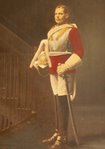I was probably about five or six years old when I first went to the Surbiton Preparatory School, at 7 Surbiton Road, St. Andrew. The school was held in the home of Mr. and Mrs. Arthur Cunningham and was operated by two of their daughters, Miss Linda and Miss Ivy. Another daughter, Miss Sybil, taught music, and I was to become one of her pupils as well.
This is the earliest advertisement I could find for the school in the Jamaica Gleaner of April 1942:
Miss Linda and Miss Ivy seem to have taken turns for the position of Headmistress as later ads name Miss Ivy in that position.
Classes were held in the large dining room and the living room, though that was reserved in the afternoons for the Surbiton School of Music, under Miss Sybil’s instruction As a child I took part in the percussion band. Here is a photo of the band
The photograph was taken on the front lawn, and one can see in the background, the house which belonged to the family of Noel Fraser, located opposite 7 Surbiton Road. I don’t recall the names of all the children in the photo.—Dennis Brennan is on the extreme left, playing the drum, and his sister, Sheila, is fourth from the left. I am fourth from the right, playing the tambourine, with Clare(Tinka) Taylor on my right, and her younger sister Rosemary (Bidi) on the extreme right. The conductor is Michael Bronstorph, the son of Dr. Bronstorph whose home was on Trafalgar Road, almost opposite to Holborn Road.
Among my photographs is one taken of what appears to be a school pageant in honour of our British heritage. We dressed up in various costumes representing the different cultures which made up the British Isles
Beverly Webster and Joanne Surridge, on either side of the group, represented the British Navy. Hazel Aird, Lena Negretti and Michael Bronstorph, decked out in kilts, were the Scottish contingent. Heather Aird, and a child whose name I have forgotten, were the Irish representatives, and myself, to the right of Joanne, and another child were togged out in Welsh costume. As you can see, from the scowl on my face, I didn’t really appreciate the tall hat. Towards the centre little Toni Negretti appears to have been some sort of fairy. It’s interesting to me now to realize that the African history of Jamaica was totally ignored in this pageant.
In looking through some of my old documents I came across the certificate and marks I earned for my Grade II Piano exam back in April 1946. I actually made the Gleaner, along with the other successful members of Miss Sybil Cunningham’s Surbiton School of Music.
I continued to play piano for quite a long time, then got sidetracked to the electronic organ and now, with age, have quite lost my pianistic ability. Still, it’s rather gratifying to look back at my score sheet for Grade II (Elementary) – Pianoforte, and remember that I once “delighted” the examiner with my playing!


















.jpg)
.jpg)



.jpg)
+--+hallway.jpg)


